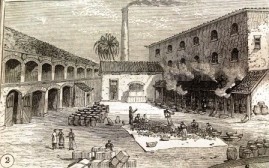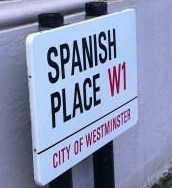The history of marmalade is well known, much loved and occasionally disputed. It is also a history of Anglicization – or more properly, perhaps, Scotticization – in which a largely Portuguese and Spanish delicacy was transformed over two or three centuries into a mainstay of the British imperial breakfast table.* By the 18th century, a British marmalade industry had sprung up, centred on Scotland and above all Dundee. Scottish companies such as Keiller’s dominated the market to the extent that the product was almost always referred to as Scotch Marmalade, its Mediterranean roots all but forgotten.
In the 1870s, however, something changed. This brief episode in marmalade history (marmaladology?) isn’t mentioned in existing histories of marmalade, and I came across it purely by chance. Stalking eBay for orange-shaped marmalade pots (don’t judge), I was struck by the number of white ceramic Victorian originals on offer – lots of Keillers, a few Frank Coopers, the odd Baxters… and one, John Moir & Son, which uniquely proclaimed a Spanish, or more precisely, Sevillean connection. As you can see from the photo above, that jar somehow made its way to the Midlands (ahem…) and I was intrigued…
As it turns out, John Moir & Son weren’t primarily marmalade producers at all. Founded in Aberdeen in 1822, the company’s main claim to fame was through its pioneering production of preserved food products such as fish, pate, French pease, sauces, soups, jellies and pickles – including the fearsome sounding ‘Pickled Aberdeen Ox Tongue.’ Scotch Marmalade was part of their range, and its seasonal nature meant that like other companies, Moir’s were accustomed to take out a big advert at the beginning of marmalade season, in December or January each year, to let customers know that the product was now in stock. The company expanded southwards during the 1870s, opening a London depot in 1871. By 1878, they had moved their head office from Virginia St, Aberdeen to the City of London.**
This southward expansion intensified in 1878 with a move unprecedented for a British marmalade manufacturer, announced in the Aberdeen Journal of 16 October under the headline A SCOTCH MARMALADE FACTORY AT SEVILLE:
Messrs John Moir & Son, of London and Aberdeen, have opened a factory at Seville, where in future their marmalade will be prepared from the oranges, which will be delivered daily, fresh gathered from the gardens. Messrs Moir have secured from the King of Spain a convention for five years permitting them alone to preserve marmalade in any part of Spain.
The company explained their move to Seville’s Calle Oriente*** as an attempt to circumvent the damage caused to Seville oranges in transit:
MOIR’S ORANGE MARMALADE prepared at the ORANGE GARDENS at SEVILLE. Having found that for several years the Oranges from Seville have arrived in this country in bad order – a large portion quite unfit for use – [J Moir and Son] have OPENED A FACTORY OF THEIR OWN AT SEVILLE, where in future their Marmalade will be made from Oranges fresh gathered from the Gardens, thus securing far greater tonic properties than when it is prepared in this country. ASK FOR MOIR’S ORANGE MARMALADE (Oxford Journal, 8 Feb 1879).
 The first season’s cargo of ‘The Seville Orange Marmalade,’ made ‘from Oranges (bitter) Gathered Daily from the Gardens in the Vicinity of Seville’ arrived in the UK in January 1879. Among the benefits claimed for the Seville-made product against its Scotch cousins were ‘Flavour and Brilliancy of Colour’ (Nottingham Evening Post, 24 Dec 1878), ‘far greater tonic properties than when it is prepared in this country’ (Oxford Journal, 8 Feb 1879), and ‘the purity of their preparations,’ using ‘Only Distilled Water’ (London Standard, 13 Nov 1879). Looking at the advertising language used, with its emphasis on the ‘orange gardens’ from which the oranges were plucked rather than the factory in which they were prepared (left, from the 2 Aug. 1884 issue of the Illustrated London News), I suspect the company were inspired by growing interest in tourism to Spain, which had won a regular place on Thomas Cook’s European tour programme just two years earlier.
The first season’s cargo of ‘The Seville Orange Marmalade,’ made ‘from Oranges (bitter) Gathered Daily from the Gardens in the Vicinity of Seville’ arrived in the UK in January 1879. Among the benefits claimed for the Seville-made product against its Scotch cousins were ‘Flavour and Brilliancy of Colour’ (Nottingham Evening Post, 24 Dec 1878), ‘far greater tonic properties than when it is prepared in this country’ (Oxford Journal, 8 Feb 1879), and ‘the purity of their preparations,’ using ‘Only Distilled Water’ (London Standard, 13 Nov 1879). Looking at the advertising language used, with its emphasis on the ‘orange gardens’ from which the oranges were plucked rather than the factory in which they were prepared (left, from the 2 Aug. 1884 issue of the Illustrated London News), I suspect the company were inspired by growing interest in tourism to Spain, which had won a regular place on Thomas Cook’s European tour programme just two years earlier.
One of the chief selling points of the Cook’s Tours was Seville, which already held a firm grip on the British imagination thanks to Carmen and the Romantics, and this seems to have been behind the decision some time in 1879 to rebrand Moir’s Orange Marmalade as Seville Orange marmalade. It was a significant move. While the term ‘Seville Orange Marmalade’ had been used occasionally by other manufacturers during the 19th century, it seems never to have stuck. Moir & Son brought the term into popular usage, restoring the Iberian dimension of ‘Scotch’ marmalade after three centuries of progressive Scotticization. Of course, this wasn’t their plan. In fact, as well as somehow gaining a patent from King Alfonso to prevent anybody else trying to produce marmalade on Spanish soil, the company also pursued an aggressive campaign against other companies that tried to use the name ‘Seville Orange Marmalade’:
The Seville Orange Marmalade is Prepared Only by John Moir and Son, London, Aberdeen, and Seville, At Their Factory in Seville. under Patent from Alfonso XII, King of Spain. All Other Brands of Marmalade are Prepared in the Old Way (London Standard, 13 Jan 1879, emphasis mine).
Later that year, in response to persistent use of the name ‘Seville Orange Marmalade’ by rival companies such as Crosse & Blackwell, who marketed a product of that name throughout 1879, they stepped up the campaign with a large advert in the national and regional press warning customers to
Beware of low-priced and adulterated imitations. To avoid these the Public are respectfully requested to see that they are supplied with THE SEVILLE ORANGE MARMALADE which is prepared only by JOHN MOIR AND SON at their MARMALADE FACTORY, which is situated among the famous ORANGE GROVES in SEVILLE (e.g. London Daily News, 20 Sep. 1879).
This advert, placed directly beneath one for Crosse & Blackwell’s product, seems to have worked. In December that year, the company announced that they had sold more than four million pounds of their marmalade in the eleven months since February (e.g. London Standard, 4 Dec 1879), and by the end of the year sales had reached 5,000,000 lbs (London Daily News, 15 Mar. 1880). In January 1880, they stepped up their campaign to claim the label ‘Seville Orange Marmalade’ for Moir’s by registering the name as a trademark, and created a new label, by which customers would be able to ensure they had the authentic product. According to the official statement in the London Daily News of 31 Jan. 1880, this was:
A Label with the words, “The Seville Orange Marmalade” over a Coloured View of our Seville Factory, and with “Manufactured only by John Moir and Son” underneath, printed in Orange Letters on a Black Ground. That Large Portion of the Public who desire to be supplied with THE SEVILLE ORANGE MARMALADE are respectfully requested to carefully see that the above label is on every Pot, jar, and tin.
As the Portsmouth Evening News noted, the new ‘prettily coloured’ labels also allowed customers ‘to detect the fresh marmalade from that which may have been for some time in stock’ (17 Jan. 1880). I haven’t yet been able to locate an example of these labels, although this image, which I’m not licensed to show you directly, may give you some idea.
Of course, it couldn’t last. As the plethora of Seville Orange Marmalades now on the market demonstrate, Moir’s were fighting a losing battle. In any case, their own priorities had changed. The company went public in 1880 as John Moir and Son (Limited) with a capital of £150,000 and turned their sights to the US market, opening a large factory at Wilmington, Delaware the following year. Their campaign to trademark Seville Orange Marmalade appears to have ceased, and although they continued marketing the product through the 1890s, it was in competition with other Seville Orange Marmalades made by Hartley’s (1887, ‘quality unequalled and always reliable’), Tiptree Heath James, Kenyon’s, and Faulder’s Silverpan (1899, ‘quality unequalled and never so popular’).
John Moir & Son only really marketed their Seville Orange Marmalade for two seasons in 1879 and 1880, and there’s still plenty to find out about their Seville operation – not least, how on earth they managed to get poor, doomed King Alfonso on board. Nonetheless, their brief campaign had a lasting effect, placing Spain – or rather, Seville – at the heart of both marmalade marketing and marmalade manufacturing. Not only is Seville Orange Marmalade now firmly ensconced in British supermarkets and the British palate, but as C Anne Wilson notes in The Book of Marmalade, the vast majority of modern marmalade now begins its life in Spain, where the oranges are harvested and the pulp is prepared (p.100). Thanks to that random EBay find, I now have a perfect excuse to carry on scouting for ceramic oranges, but more importantly, Moir’s marmaladological innovations will – I hope – find their proper place in marmalade history.
Notes
* As C Anne Wilson records in her excellent history, The Book of Marmalade, the word ‘marmalade’ (from the Portuguese ‘marmelada’) originally referred to any cooked preserve of soft fruit, a meaning it has retained in many European countries today. Only in Britain, where Portuguese, Spanish and Italian marmelada or quince jelly was imported in the 15th century and possibly earlier, has it become identified solely with citrus fruit, above all the gloriously bitter and highly seasonal Seville oranges. And once we Brits had found our take on marmalade – initially considered to have medicinal, digestive, or even aphrodisiac qualities – we claimed it for our own.
** The location of the company’s London offices during the 1870s varied, but included 1A Adam St (1871), 14 Commercial St (1872), Glasshouse Field / Brook St (1878), 148 Leadenhall St (1878) and 9-10 Great Tower St (1880).
*** I haven’t yet identified the exact location of the factory, although it seems Seville’s original Calle Oriente may now be called Calle Luis de Montoto. This post from Julio Domínguez Arjona on ‘La Sevilla que no vemos,’ has more information and some early photographs.
More About Marmalade
C Anne Wilson. The Book of Marmalade. Philadelphia: U Pennsylvania Press, 1999 [first published 1985].

